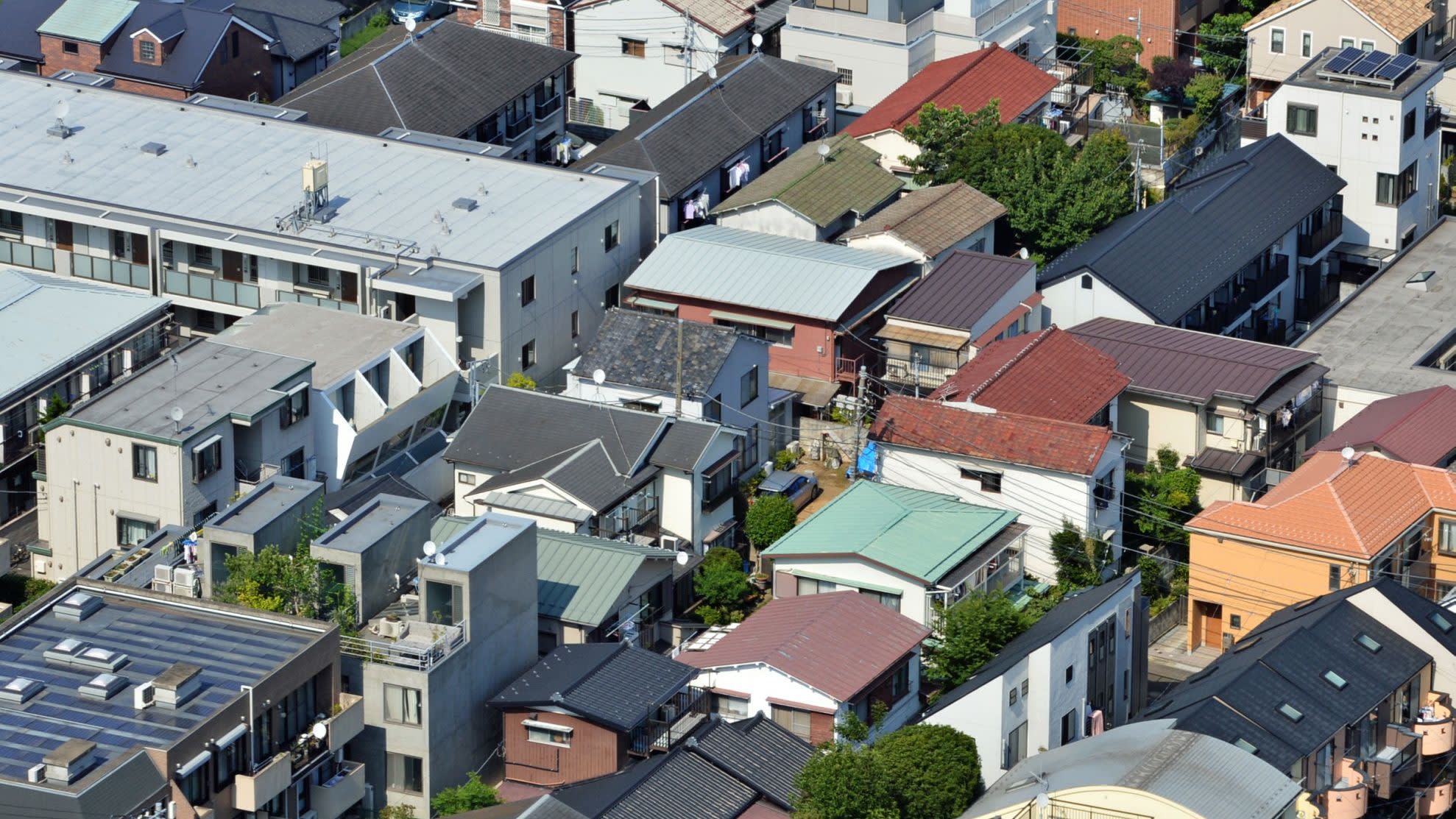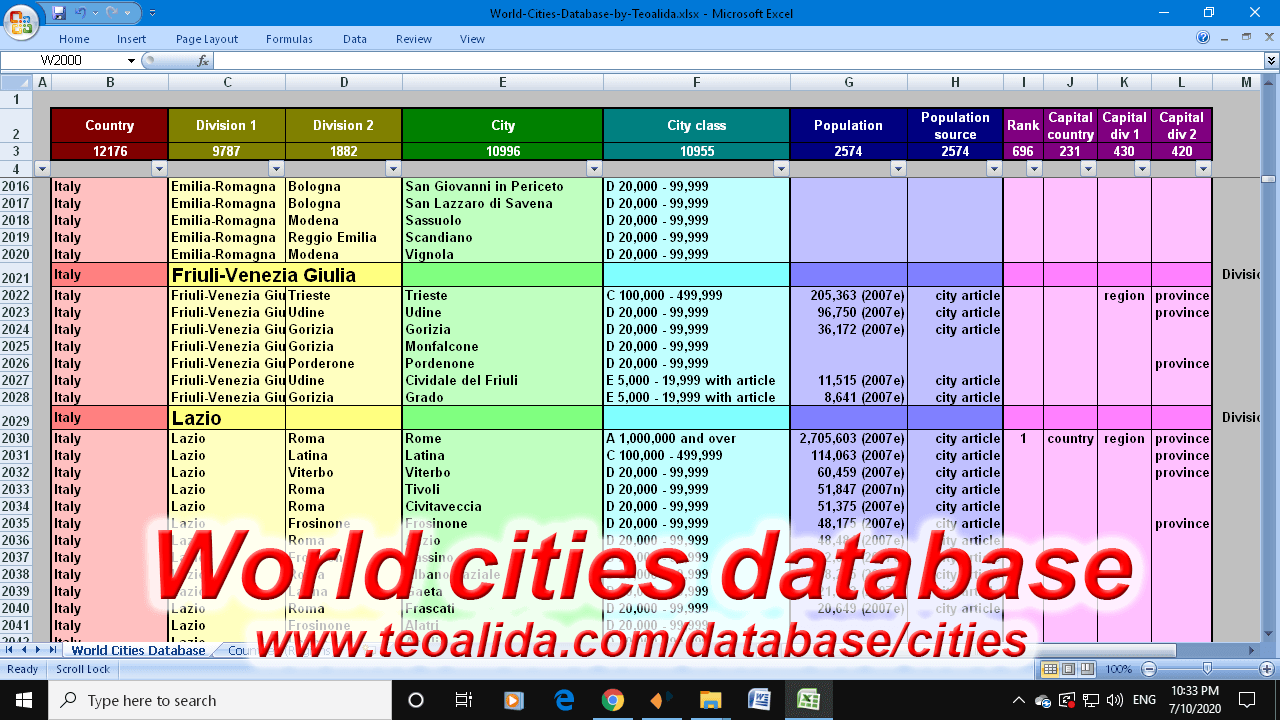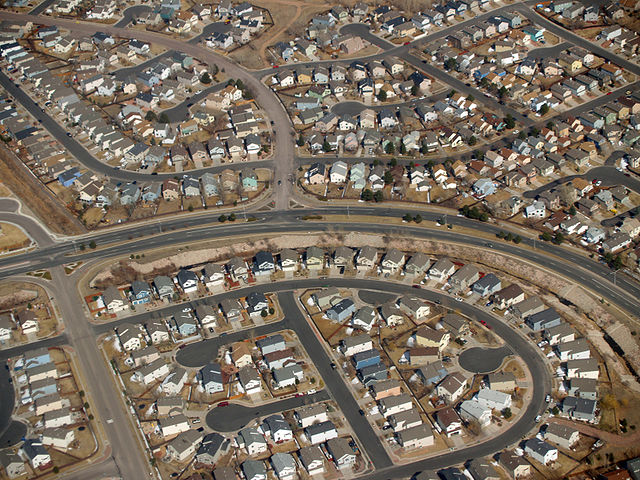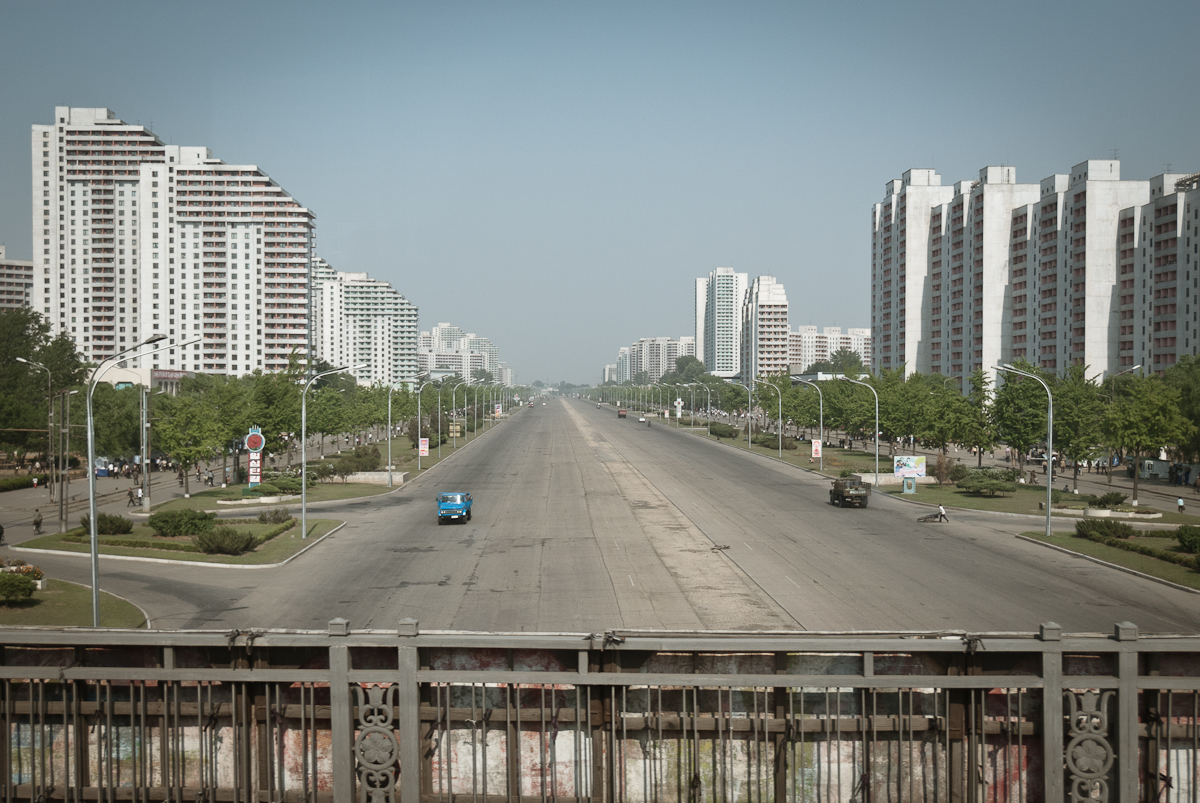Japan is one of the best places to live, the economy boomed after World War II but since 1990s the rising was very slow, it is still one of the most advanced economies in the world, highest standard of living, where everything run as it should, BUT… Japan is also one of the ugliest of all developed countries. They simply suck at architecture and urban planning. Except the downtown with skyscrapers, Tokyo skyline is dominated by ugly dense buildings and lots of cables hanging on streets.
Chapters: statistics – planning – public housing – landed houses – skyscrapers – transportation – about
 Most Japanese live in extremely dense detached landed houses. Residential roads (even 2-lane ones) are 4-meter width, no sidewalks, and are occasionally blocked by poles for power lines. Two cars cannot run in parallel over all length of street, but can pass along each other in certain places.
Most Japanese live in extremely dense detached landed houses. Residential roads (even 2-lane ones) are 4-meter width, no sidewalks, and are occasionally blocked by poles for power lines. Two cars cannot run in parallel over all length of street, but can pass along each other in certain places.
Apparently there is no rule about minimal distance between buildings, I heard of a 50 cm rule, but in most cases houses are 2 meters each other. The housing density reaches 40-50 houses per hectare, a world record for detached houses.
I love Korea much more than Japan, because Korea have over half of population living in large apartment complexes with a lot of green space around. China and Singapore are also dominated by apartments. Can anyone tell me what is better in Japan compared with nearby Asian countries?
Japan housing statistics
Average home size in Japan is 95 square meters, share of detached houses is 56% (44% are apartments and terraced/semi-detached (rare in Japan), average home size varies across the country, depending of share of detached houses, from 65 sqm in Tokio which have plenty of apartment buildings, to 150+ sqm in small cities, according Demographia page (2003 data), average 37 sqm per capita according another Demographia page (1998 data). 60.9% of homes are owned, average owned home is 121.7 sqm according Wikipedia. Can someone clarify me if these numbers include walls and balconies?
Japan urban planning
Japan urban planning is done nationwide with only 12 zoning types, ranging from residential to industrial.
Some articles interesting to read:
alatown.com/japanese-building-law/
toshiseibi.metro.tokyo./lg/eng/
urbankchoze.blogspot.com/2014/04/japanese-zoning.html
Who love crazy architecture should see Nakagin Capsule Tower, 10 sq m units.
Japan public housing
Public housing in Japan, danchi apartment buildings, are built by Japan Housing Corporation since 1955 aimed to poor people, corridor-style and staircase-style (2 units per floor), rows of identical buildings, oriented with front facade to south, with 4 or 5 floors, most are already demolished today or will be demolished next decade. New danchis were built, taller and with more modern apartments. All danchi apartments come with balconies, and unlike other countries, no balcony is closed (is this a law?).
By measuring the blocks in Google Earth’s satellite photos, I estimate that the common apartment size is 60 sqm 2-bedroom and 80 sqm 3-bedroom (few), but the internet shows apartments small as 3 sqm, I do not know where they are located (apartment only contain a folding bed, toilets are shared).
Japan landed houses
Private housing in Japan is composed by landed houses, mostly in 100-200 sqm range, 3-4 bedrooms, with few exceptions (sometimes 2 houses crammed on one lot), and small apartment blocks, having units much smaller. Seems that Japanese people are conservative, making economy and not building bigger things than is necessary, same thing is true for cars too.
Most houses are made of wood and are not designed to last, there is common that when a property is transacted, the buyer does buy just for land, demolish the house and rebuild another. 80% of houses are less than 30 years old. Source: freakonomics.com.
Wooden buildings are allowed to have a maximum of 2 floors, some houses are built on top of a basement floor that include parking lot (especially on hills) and others are made completely of brick and concrete.
Typical landed housing neighborhoods in Japan
Houses crammed one in other and very narrow roads between them

Houses are being built next to railway (wasn’t normal to be a buffer of trees next to railway to reduce sound?)


Here is a neighborhood that actually look nice (Urayasu, Chiba Prefecture), grid housing lots, not messy like above ones
Japan skyscrapers
Japan have numerous tall buildings, but because of earthquakes, there are no supertalls like in South Korea, China or Hong Kong. Abenobashi Terminal Building is the tallest building in Japan, 300 meters and 60 floors, built in 2014. Toranomon Hills is the tallest building in Tokyo, 256 meters, 57 floors, also built in 2014. Tokyo Skytree, 634 meters, built in 2011, is the tallest structure (not building) in Japan and at the time it was built it was second tallest structure in the world, after Burj Khalifa.
View from Tokyo Skytree: a mess of houses, apartments and office buildings
Transportation
Japan is pioneering in high-speed trains. Shinkansen began service in 1964 from Tokyo to Osaka (515.4 km), today the network have 2,764.6 km of lines with maximum speed of 240-320 km/h. Shinkansen network had the highest annual ridership of any high-speed rail network until 2011 when Chinese high-speed railway took the lead.
Japan is the world leader in car manufacturing, overtaking United States since 1973, if the light trucks are included, United States overtook back Japan for short periods during 2000s. But in 2010 Japan lost the title in favor of by China. Since 1990s, Japanese cars are recognized as most reliable in the world.
Japan car market is most regulated in the world, it is the single country where cars are taxed by dimensions (and I appreciate this!). Since 1951 or 1955 (contradictory sources) 3 classes for car tax were defined:
– Kei cars were in 1949 limited to 3 meters length and 1.3 meters wide, the regulations were gradually increased over time, currently (since 1998) the limits are 3.48 meters length, 1.48 meters wide, and 660 cm³.
– Compact cars are limited to 4.7 meters length, 1.7 meters wide, 2 meters tall, 2-liter engine.
– Bigger cars are heavily taxed.
So most car models manufactured in Japan for domestic market stick under these limits, while car models exported are bigger even if they wear same name. These rules allow two cars to pass along each other on typical residential roads that are 4 meters wide. However, since 2000s Japanese manufacturers launched more and more car models that exceed the limit of compact cars especially in width, to compete with boom of imported models which are wider. If 30% of cars sold in United States are from Japan manufacturers, only 0.3% of cars sold in Japan are made by US manufacturers (source: this video).
About
Page published for first time in 2011 and updated over next years with more information found by me or provided by visitors. Text written by me (Teoalida) and images taken from Wikipedia, Panoramio and other websites. Do you have useful information that worth adding? Did you found an error or have a contradictory opinion? Leave a comment!










Japan has many old buildings but only you find them ugly because you don’t appreciate old wooden architecture. Yes, old but very beautiful. It’s where the traditional Japanese atmosphere lingers..not just in new technology and skyscrapers.
Which wood architecture? I explored random areas from city centers to suburbs and never saw wood houses. But probably if I would see wood houses I would hate them anyway. Do you noticed that all my 10 Best Cities in the World have majority of population living in apartment buildings?
Janan is a developed country. I have a plan to visit there someday.
Are you kidding? I traveled japan and south korea several times, I don’t like the housing of Korea because most part of housing is apartment, just like my hometown Wuhan, China. I hate so many people live in tall building, making me repressive. In china, a family who owns a detached houses or villa is rich.
Although the size is smaller than U.S. and Europe, most people in Japan live in detached houses, called “一戸建“, like the small villa, including a parking lot and a small garden.
The picture you choose in this page is not typical for Japanese housing, which make your research suck. Instead of finding some data and articles from internet, you should use the google map + street view to see the actual picture, choosing a mass of location in google map across the Japan and Korea, from big city to small town, from urban to suburb.
IMHO, Seoul living condition is the worst in developed country when I see the google map + street view located in Seoul.
BTW, you are a layman of history of Automotive industry, which means your opinion is wrong.
At the time I wrote article in 2011 I was fascinated by apartment living, the interest for houses came later, and I am sorry for biasing article on my personal preference instead of showing ALL housing types in this country. Over next years I browsed Google Streetview a lot to study landed houses, but did not added photos on page, sorry for that. I will look around soon for some photos of houses to add.
I study automotive industry for 18 years, making https://www.teoalida.com/cardatabase/ , why do you say that my opinion is wrong?
I bet $500 for this.
You’re Japanese.
Three grounds for my assumption
1) Speaking ill of Korea
2) Your English can very naturally be translated into Japanese because of the composition structure is same.
3) Your logic is very “Japanese”.
Not at all. I’m French and he’s right South Korea architecture is terrible. Housing complexes and brick villa look so bad.
just checking it out. da.,usa ca.
for far i would like to find about housing condominium for 2 people. 1bathroom and 2 bedrooms condominium for two people for ex.
just want to ckeck about a condominium with 2 bedrooms and one bathroom for 2 people.Danilo a Usa. ca.best.
I am NOT real estate agent so I don’t sell properties. You post comments in a page about Japan housing to buy property in California, USA? If I understood your comment wrongly and you need something else, please explain more clearly HOW I CAN HELP YOU?
Sorry but South Korea is ugly. I’m French so I HATE all these housing complexes which all look the same. It look like French post war social housing build in emergency during the baby boom.
Japan is dense and packed, full of live and culture. It’s very ecological than all these big high rise.
Japan really has managed to make best use of the land available. In non western world only japan has properly laid detached housing residential areas .its really impressive Japanese citizen are having some good personal space .
When I see S.Korea I always find appartments standout all other buildings . Its hella cramped just tòo many of them even in suburbs.
No detached housing district there.
Its really that housing is terribly
done in korea. Tokyo is over twice the size of seoul and still it has nicely done housing in suburbs . Well one of the reasons I dont like korea that much is its poor housing that is reasonably the worst in developed world . I mean how many westerns love living in appartment blocks . And then Japan has adapted the western style houses even though no yards but still good .That’s what I like .
A lot of Western Europeans live in apartment blocks, especially those in Spain and Italy, but they are built in many different styles… indeed South Korea apartments look all the same, is this the reason for which you call the housing here the worst in the world? Living conditions inside are among the best in the world. There are also single family / detached houses and small villas in South Korea if someone want to have own yard, but most koreans prefer living in high-rise apartments.